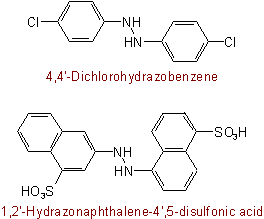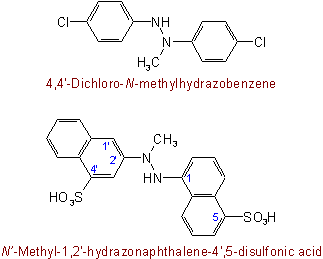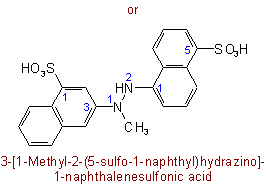
ACD/Name (Chemist Version) offers a standardized set of features for quick and simple generation of IUPAC names, and structures from names. It is a streamlined version of our popular ACD/Name software.
View a full description and pricing on our web store.

921.2 - Alternatively, for compoundsExamples to Rule C-921.1
 in which the radicals
in which the radicals  and
and  are derived from parent molecules that, when unsubstituted, are
identical, names may be formed by methods analogous to those used for azo compounds (Rules C-911 and C-912) but with "hydrazo" in place of "azo". The names so obtained are
available for indication of further substitution on the nitrogen atoms provided that no ambiguity is caused thereby; when ambiguity would be caused thereby, the compounds are named according to Rule
C-921.1.
are derived from parent molecules that, when unsubstituted, are
identical, names may be formed by methods analogous to those used for azo compounds (Rules C-911 and C-912) but with "hydrazo" in place of "azo". The names so obtained are
available for indication of further substitution on the nitrogen atoms provided that no ambiguity is caused thereby; when ambiguity would be caused thereby, the compounds are named according to Rule
C-921.1.
921.3 - When one nitrogen atom of a hydrazine group forms part of a ring the compound is named as an amino derivative of the heterocycle.Examples to Rule C-921.2

(compare Rule C-911.1)
or 3,5'-Hydrazodi-(1-naphthalenesulfonic acid)
(compare Rule C-912.2)

(compare Rule C-911)

(compare Rule C-912)
921.4 - A group -NH-NH- attached to a single carbon atom is denoted by a prefix "hydrazi-" when another group having priority for citation as principal group is also present. See, however, Rule B-1.Example to Rule C-921.3
921.5 - Compounds formed by replacement of hydrogen of a hydrazine group by an acyl group, and their further substitution products, are named by one of the following methods: (a) If a substituent having priority for citation as principal group is also present, the compound is named as an acylhydrazino compound (compare Rule C-921.1); the nitrogen atom attached to the parent carrying the principal group has the locant N (unprimed) or 1. (b) If there is no substituent having priority for citation as principal group, the ending "ic acid" or "-oic acid" of the name of the acid is changed to "-ohydrazide"; or if the ending of the name of the acid is "-carboxylic acid", this is changed to "-carbohydrazide"; the nitrogen atom attached to the acyl group then has the locant N or 1'.Example to Rule C-921.4
921.6 - Salts of hydrazines are named as derivatives of hydrazinium(1+) or hydrazinium(2+), according to whether one or both nitrogen atoms bear a charge (see Rule 3.17 of I.U.P.A.C. Nomenclature of Inorganic Chemistry, 1970Examples to Rule C-921.5
 ). If only one nitrogen atom bears a charge and it is known which, then that atom has
the locant N (unprimed) or 1.
). If only one nitrogen atom bears a charge and it is known which, then that atom has
the locant N (unprimed) or 1.
921.7 - Acyclic polyhydrazines may be named by replacement nomenclature (see Subsection C-0.6).Examples to Rule C-921.6
See Recommendations'93 R-5.6.6, R-5.7.8.4Example to Rule C-921.7


Published with permission of the IUPAC by Advanced Chemistry Development, Inc., www.acdlabs.com, +1(416)368-3435 tel, +1(416)368-5596 fax. For comments or suggestions please contact [email protected]